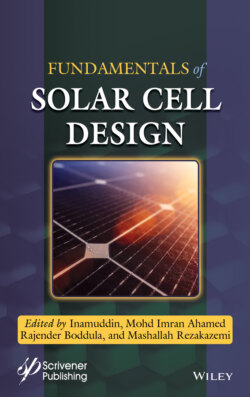Читать книгу Fundamentals of Solar Cell Design - Rajender Boddula - Страница 29
2.1 Introduction
ОглавлениеSolar energy is cleanest energy source among other renewable energy. Earth receives annually about 1.7 × 105 TW energy on the surface of earth that is thousands times more than the total energy consumption of world, i.e., 12–13 TW [1]. Solar cell is a solar energy conversion device that works on photoelectric effect, which is schematically shown in Figure 2.1. The ejected electrons are called photoelectrons [2]. Photovoltaic (PV) cell converts light energy into electrical energy that can work on small and large-scale applications. Solar cell technology can make an important contribution to solve the energy problem on earth for the benefit of the society. The absorber material in solar cell absorbs the sunlight upon and then the electron-hole (e-h) pair is produced. The generated e-h pairs are needed to separate by completing a electric circuit to collect electrons as a flow of current. The cost of solar PV manufacturing is high due to expensive fabrication and toxic elements, which makes this technology less commercialized as compared to fossil fuels and nuclear energy [3, 4].
Schockey-Queisser limit suggests that the efficiency of solar energy to electric energy conversion for a single junction PV device can be achieved upto about 32%. The efficiency for cell consists of two layers, three layers, and a theoretical infinity layer can reach upto 42%, 49%, and 68%, respectively. An existed thin film solar cell technology with midgap infinite bands suggests a maximum efficiency of 77.2%. The single junction monocrystalline and polycrystalline silicon solar cells provide efficiencies about 20%–24% [5, 6]. Silicon solar cells are widely used to develop solar panels for generating electricity. The most of the price in this technology is because of silicon wafers and cell fabrication processes. Therefore, the advanced research is required in solar cell technology to find novel and cheap materials [7]. The thin film PV devices such as CIGS (~21%), GaAs (~37%), cadmium telluride (CdTe, ~19%), and CZTSSe (~13%) have been developed as alternative to silicon but low absorbance of near band gap light is a major problem [8, 9]. The usage of rare earth and toxic elements in CIGS, GaAs, and CdTe solar cells has made them less successful in market. Therefore, the novel design in device configuration is required to absorb maximum sunlight in solar cell. The various nanomaterials such as quantum dot, nanowire, thin film, and biomaterials can be used in combination to improve the performance of PV device. These combinations can enhance the light trapping on the surface of the PV cell. The biohybrid materials have been utilized to absorb wide range of sunlight for developing dye sensitized solar cells (DSSCs) as well as photoelectrochemical cells (PECs). They have achieved maximum efficiency of 30% at research scale [10, 11]. The multijunction solar cells have been demonstrated with maximum conversion efficiency of about 47%. The various intermediate layers have been explored in multi-junction solar cells enhancing the absorption of light and decreasing the recombination rate of e-h pair [12–14]. These solar cell technologies are summarized in Table 2.1.
Figure 2.1 Schematic representation of photoelectric effect. Einstein equation hf = ɸ + Ek, where h is plank constant (6.63 x 10-34 Js), f is the frequency of the incident light (Hz), ɸ (phi) is the work function (J), Ek is the maximum kinetic energy of the emitted electrons (J).
The major challenges for developing high efficient solar cells are increasing light absorption and minimizing recombination. The tuning in the energy band gap can be useful to overcome these challenges. Recombination loss can be decreased by making thinner solar absorber in PV device. The PV absorber layers are generally thick to allow absorption with near wavelength and collection photocurrent. A major percentage of solar light spectrums are not absorbed in thin film solar cells, and hence, they are facing problem of low efficiency in comparison to traditional Si cells. Nanotechnology has the ability to make more efficient materials and PV devices. Plasmonic nanostructures can be helpful to reduce the thickness of PV absorbers while keeping their optical thickness constant. In plasmonic solar cells, the plasmon resonances in small metal nanoparticles are used to trap light. Then they transfer the energy to thin semiconducting layer to produce electricity through free charge carriers [15–17].
Table 2.1 Various solar cell technologies and its efficiency.
| Solar cell technology | Maximum efficiency | Reference |
| First generation: Single junction Mono-crstalline and poly crystalline silicon, GaAs solar cells | ~20–24% (silicon)~ 38% (GaAs) | [7, 17, 90–92] |
| Second generation: Thin film solar cells such as CIGS, CdTe, CZTSSe, DSSCs | ~ 21% (CIGS)~ 19% (CdTe)~ 13% (CZTSSe)~ 18% (DSSCs, PECs) | [7, 17, 93–101] |
| Third generation: Hybrid DSSCs, PECs, quantum dot, perovskites, plasmonic solar cells | ~ 30% | [7, 102–104] |
| Fourth generation: Multijunction solar cells with GaAs, InP and other intermediate layer | ~ 47% (multijunction GaAs) | [7, 105–112] |
